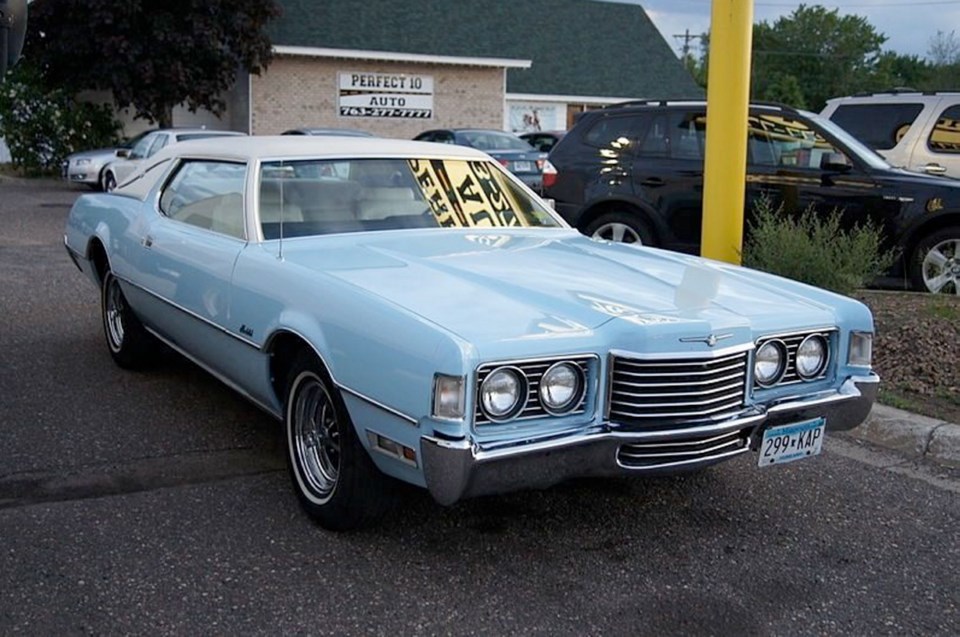When the Ford DivisionŌĆÖs astute general manager, Robert McNamara, took the Thunderbird from a two-seater sporty car to a four-seater ŌĆ£personal luxuryŌĆØ car in 1958 he expected it would be more profitable. It proved to be an excellent prediction.
Sales jumped to almost 38,000, more than the previous two years combined. McNamara had set the Thunderbird on a new size and class trajectory that would peak in the 1970s. It would also set his own career on a trajectory to the presidency of the Ford Motor Co. in 1960.
The 1958 Thunderbird grew from its original length of 4,453 mm (175.3 in.) in 1955 to 5,217 (205.4) where it stabilized until 1966. It then grew to 5,331 mm (209.9 in.) for 1967.
The arrival of the 1972 sixth generation Thunderbird was the launch of its greatest period of growth, and its large step to a 5,436 mm (214 in.) length seemed to be just what the market wanted, boosting sales from 57,000 ŌĆÖ71s to 87,000 ŌĆÖ72s. This two-door hardtop (the only offering) was so large it shared its body-on-frame architecture with the Lincoln Continental Mark IV.
Underneath was typical American hardware with independent A-arm-and-coil-spring front suspension and solid axle on coil springs at the rear. Brakes were power assisted disc front and drum rear. The only transmission was a three-speed automatic.
Power came from the standard 7.0 litre (429 cu in.) overhead valve V-8 or optional 7.5 (460) V-8, both down significantly in power ratings from the ŌĆÖ71s. The 7.0 litre was listed at only 212 horsepower compared with 360 the year before.
There were a couple of reasons for the apparent loss of power. First was the change in the horsepower rating method from SAE (Society of Automotive Engineers) ŌĆ£grossŌĆØ rating to more realistic SAE ŌĆ£net,ŌĆØ i.e. as installed in the car.
The other reason was reducing compression ratios to accommodate the unleaded gasoline required by exhaust-cleansing catalytic converters.
There were none of the original sporting pretensions in the ŌĆÖ72 ŌĆśBird: it was a large luxury car pure and simple with a 3,058 mm (120.4 in.) wheelbase and nearly 2,032 mm (80 in.) width. It had the classic long hood/short deck profile and taillamps from wall to wall. Weight was a hefty 1,996 kg (4,400 lb).
For those who purchased cars based on mass and size it was irresistible.
Consumers loved the big ŌĆśBird and the millionth Thunderbird that came off the line was a 1972 model.
There were no big changes for 1973, except for an eggcrate grille rather than horizontal bars, and opera windows that slightly improved visibility. A further compression decrease reduced power to 201 for the 7.0 litre (426 cu in.) but buyers didnŌĆÖt seem to care as long as they got their coddling luxury.
Unfortunately for Ford and other American auto manufacturers, disaster was on the horizon. The first ŌĆ£oil crisisŌĆØ of the 1970s, caused by an Organization of Petroleum Producing Countries oil embargo would arrive late in 1973.
This tripled the price of oil, increased the price of gasoline and even more alarmingly, threatened its supply.
It reduced demand for large V-8-powered cars with the result that ThunderbirdŌĆÖs sales of ŌĆÖ74 models, now with the big 7.0 litre (460 cu in.) V-8 fell to 57,000.
Model lead times being what they are, Ford couldnŌĆÖt turn the T-Bird around on a dime and 1975 and 1976 models were little changed. A ŌĆ£quick defrostŌĆØ option promised faster window defrosting via a thin gold film embedded in the glass, but it proved to be a power hog and was discontinued in 1976.
The ŌĆÖ75s got optional four-wheel disc brakes, and thanks to government mandated five mph (8 km/h) bumpers it reached a length of 5,740 mm (226 in.), the longest Ford ever.
Times were turning against cars like the huge Thunderbird and 1975 sales fell to 42,000. But consumersŌĆÖ memories are short and when the oil crisis ended, sales rebounded to 53,000 for 1976.
In spite of improved ŌĆÖ76 sales, it was clear the future lay in smaller cars.
With fuel economy legislation on the horizon, the Thunderbird would start shrinking with its 1977 seventh generation. It would get a six-cylinder engine, and even a four in the ŌĆÖ80s, much to the chagrin of many Thunderbird fans.
The 1972-1976 Thunderbird was caught in the transition to smaller, more sensible and economical cars.
It was the epitome of the big, garish models that made Motor City rich, dominant and some said even arrogant during the 1950s, ŌĆÖ60s and ŌĆÖ70s.
Those big ŌĆÖBirds now stand as monuments to a more profligate era when gasoline was still cheap and bigger was better.
In an energy- and environmentally challenged world, itŌĆÖs unlikely we will see their ilk again.



